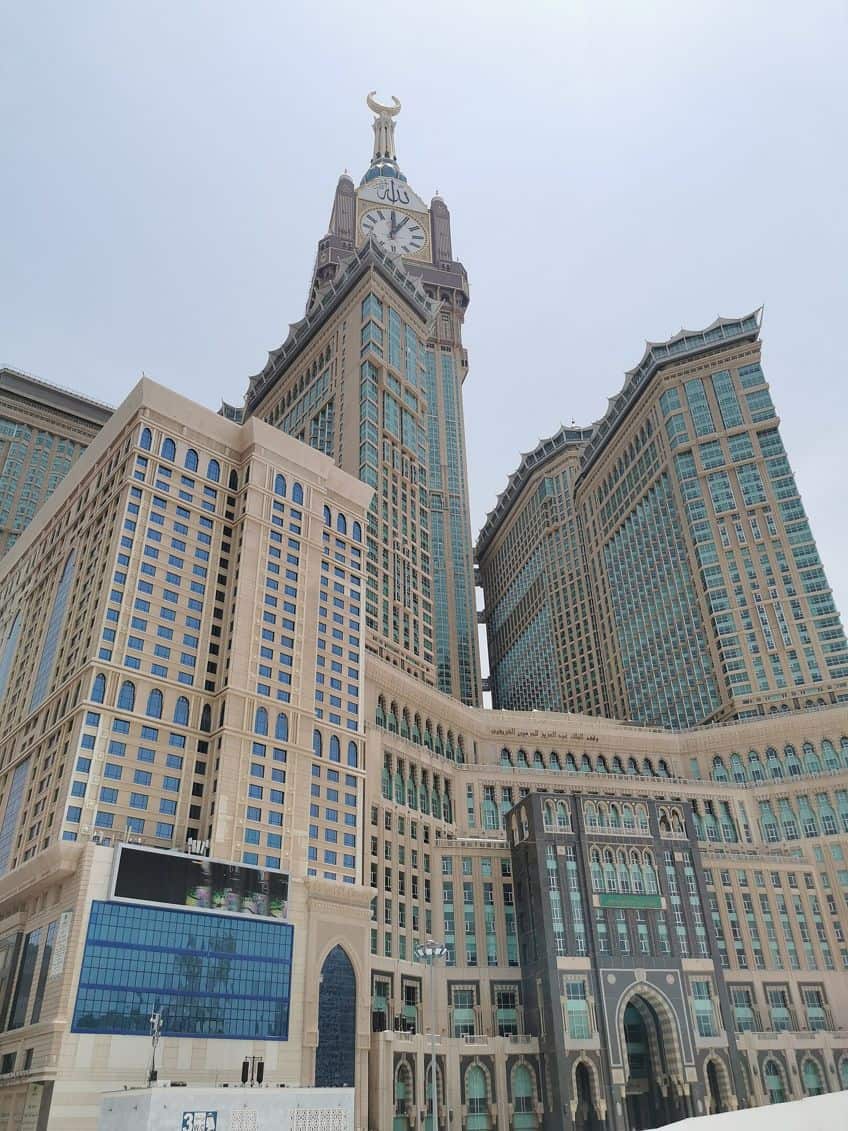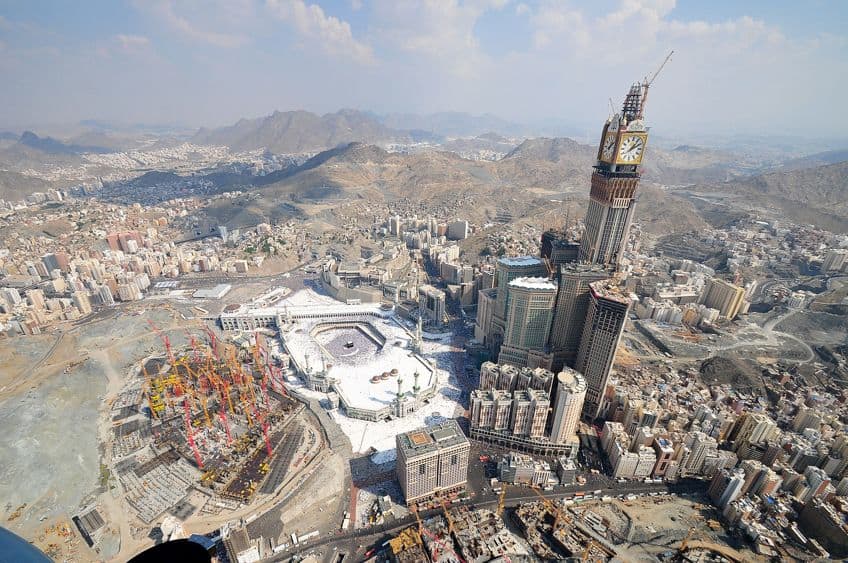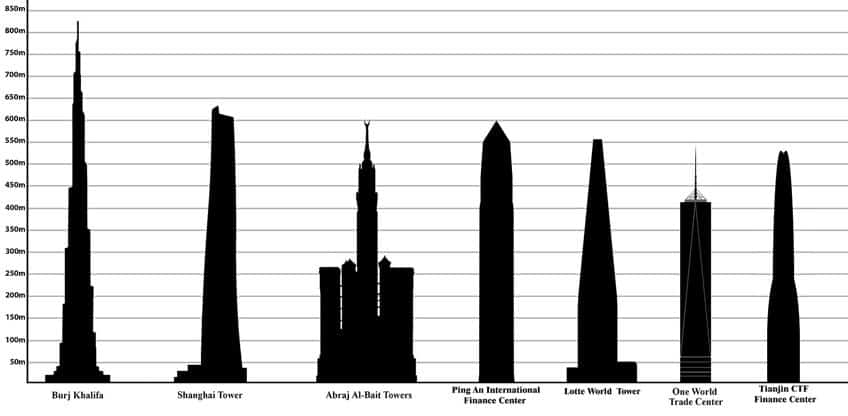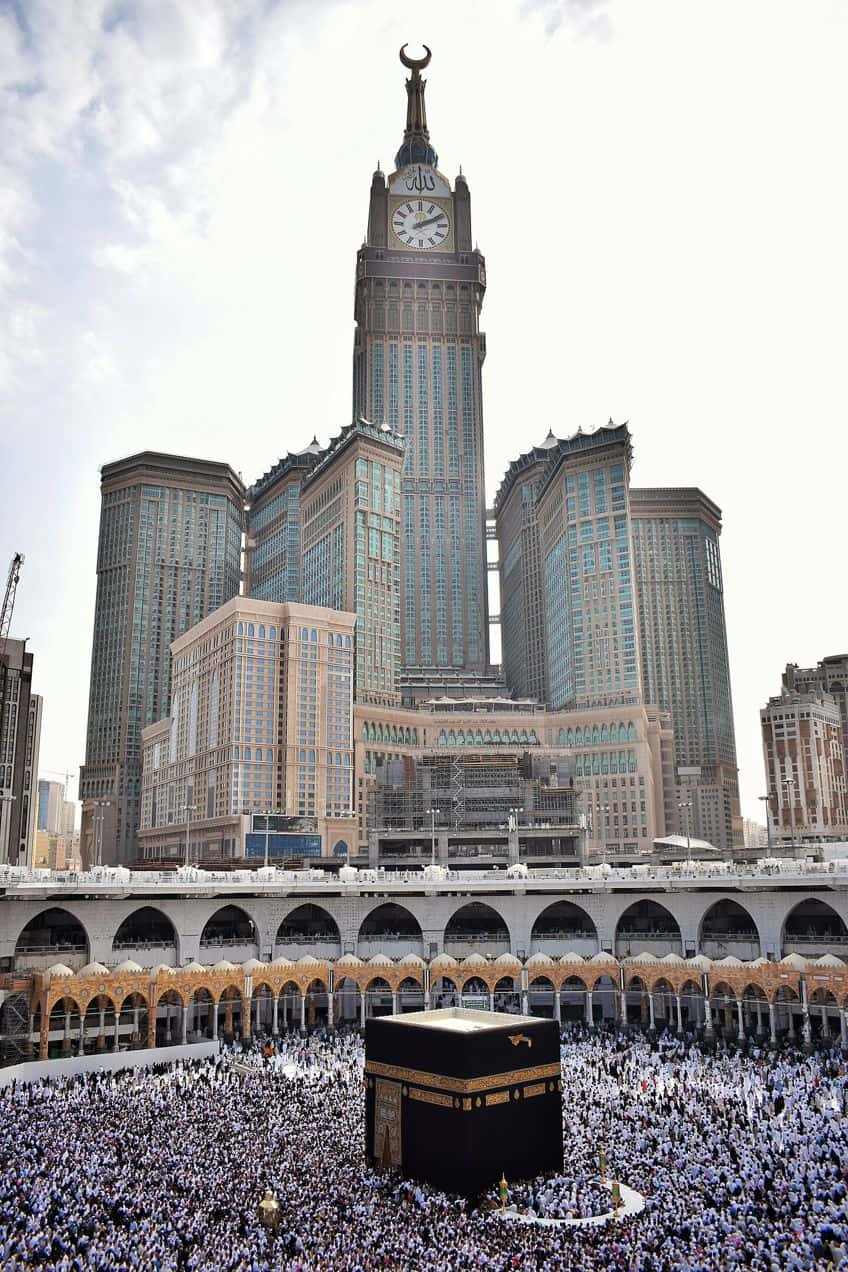Makkah Royal Clock Tower – The Giant Clock Tower’s History
The Makkah Royal Clock Tower is part of the larger Abraj Al Bait hotel complex, and it is a series of hotels found in Mecca near the Great Mosque for which pilgrims visit the city. In this article, we will examine the general architectural elements of the Makkah Royal Clock Tower, the location in which this giant clock tower is located, the clock itself, and the brief history of this building and its surrounding skyscraper neighbors. Keep reading to learn more about the Makkah Royal Clock Tower and the Abraj Al Bait complex.
Contents
- 1 A Look at the Makkah Royal Clock Tower
- 2 Frequently Asked Questions
- 2.1 Where Is the World’s Tallest Clock Tower?
- 2.2 What Is the Makkah Royal Clock Tower?
- 2.3 What Is the Architectural Style of the Makkah Royal Clock Tower?
- 2.4 What Structure Was Demolished to Make Way for the Makkah Royal Clock Tower?
- 2.5 What Is Significant About the Location of the Makkah Royal Clock Tower?
A Look at the Makkah Royal Clock Tower
| Architect | SL Rasch GmbH and Dar Al-Handasah Architects |
| Date Constructed | 2002 – 2011 |
| Function | Mixed-use |
| Materials Used | Concrete, steel, and glass |
| Height | 601 m (or 1,972 ft) |
| Location | Mecca, Saudi Arabia |
The Abraj Al Bait is a large complex of skyscrapers located in Mecca. This collection of seven skyscrapers is raised up high above the streets of the city, and while each of them is rather gargantuan in size, it is the central giant clock tower that is the tallest of them all. The central tower is known as the Makkah Royal Clock Tower.
This central tower is the fourth-tallest building in the world. Atop the tower is a massive clock tower, the tallest in the world, and the clock itself is made up of four of the building’s total floors.
This gigantic array of skyscrapers is situated in Mecca for one simple reason: to serve the pilgrims who arrive in the city. This giant clock tower, along with the six other skyscrapers that flank it, are hotels that are able to cater to thousands of would-be pilgrims to the city, and the complex as a whole is situated close to the Great Mosque of Mecca that pilgrims are meant to visit.
 Makkah Royal Clock Tower (2021); AhmadElq, CC BY-SA 4.0, via Wikimedia Commons
Makkah Royal Clock Tower (2021); AhmadElq, CC BY-SA 4.0, via Wikimedia Commons
The Makkah Royal Clock Tower includes various other amenities and quality-of-life features for those who are visiting this important city for the Islamic faith, and many of these will be discussed in more detail below but include features such as the large mall and museum that can be found in the structure. However, the ultimate reason that this complex of structures was constructed is thanks to the King Abdulaziz Endowment Project.
The idea behind this royally decreed project is for the modernization of Mecca to help the city withstand the modern world’s explosion of growth. In ancient times, it was far easier to handle the influx of visitors as they were, quite simply, fewer people in the world. But times have changed. There are now billions of people on the planet, and the number of Islamic individuals who need to visit this sacred site has expanded too. So, this hotel and clock tower in Saudi Arabia provides a place for them.
The King Abdulaziz Endowment Project led to the creation of several other aspects of modernization in the city, but the Makkah Royal Clock Tower serves as the most prominent of these plans, and it has gone on to become one of the most famous structures in contemporary architecture because of its sheer scale and its dedication to an Islamic architectural style that incorporates elements from the culture and religion into the design of the building itself.
The Architecture of the Makkah Royal Clock Tower
In general, the Abraj Al Bait is a Postmodern structure in basic design, but the term “Postmodern” is an incredibly broad one that does not necessarily incorporate everything that one may expect from an architectural style. One of the central tenets of Postmodern architecture is a dedication to a denial of the kind of universalism and internationalism of Modernism which it is a response against.
There are many different Postmodern architectural styles, and many of those styles prefer to incorporate vernacular architectural elements when designing a structure.
This means that buildings constructed using a Postmodern design do not all look like the Guggenheim Museum Bilbao. They are not all intricate, weird, and/or organic shapes. A Postmodern structure can be as simple as taking architectural principles of the past and integrating them into a more high-tech style. This is exactly what was done with the Abraj Al Bait as a whole and the Makkah Royal Clock Tower in particular.
 Construction of the Abraj Al Bait Clock Tower (2010); Fadi El Benni of Al Jazeera English, CC BY-SA 2.0, via Wikimedia Commons
Construction of the Abraj Al Bait Clock Tower (2010); Fadi El Benni of Al Jazeera English, CC BY-SA 2.0, via Wikimedia Commons
This clock tower in Saudi Arabia is stunning in its extraordinary scope as it incorporates elements of vernacular Islamic architecture while also, interestingly, making use of some of the elements from an entirely distinct Postmodern form: New Classical architecture. This form of architecture is an attempt to reuse Classical elements, such as columns and domes while integrating them into a more contemporary form. The use of Classical elements, which are descended from Ancient Greek and Roman architecture may appear to be an unusual sight in a clock tower in Saudi Arabia, but it actually isn’t at all.
It was the Islamic world that reintroduced much of Ancient Greek culture back to the West after it was lost, and so there is a long history of Ancient Greek scholarship and influence in Islamic nations. So, in general, the Makkah Royal Clock Tower makes use of a more vernacular Islamic architecture style through a Postmodern lens while also making use of certain New Classical elements, but this is only in general, what about in more specific terms?
The Makkah Royal Clock Tower was constructed around a concrete and steel general design, but the most notable aspect of the building is the clock and spire.
The clock will be discussed on its own, but the spire is something else entirely. The spire is eight stories tall on its own, and it is covered in a glass façade that has been tinted gold. The entire structure has also been topped with a crescent symbol. The crescent symbol is massive and weighs a total of 6 tons. It is 21 m (or 69 ft) in diameter and can be seen, like the clocks, for miles in every direction. The crescent moon is an integral symbol of the Islamic faith and it, along with the Arabic script on the clock faces, contributes to the Islamic architectural design that is so central to the Makkah Royal Clock Tower.
The Height of the Makkah Royal Clock Tower
The Makkah Royal Clock Tower is absolutely colossal in size. The building is 601 m (or 1,972 ft) in height, and it’s comprised of 120 stories worth of hotel, museum, and commercial space. This incredible height means that it is shorter than the Shanghai Tower, but taller than the Ping An Finance Center and is, therefore, the fourth-tallest building in the world. On top of this, it is also the tallest clock tower in the world. However, the initial plan had been for the building to be over 100 m taller at 734 m (or 2,408 ft), but the plan ultimately fell to the current height. That height is, regardless of its technical reduction, still a gigantic structure. The originally planned height would have made it the second-tallest building in the world after the Burj Khalifa though, but its current height is still more than enough.
 The 7 tallest skyscrapers in the world (2020); Saggittarius A, CC BY-SA 4.0, via Wikimedia Commons
The 7 tallest skyscrapers in the world (2020); Saggittarius A, CC BY-SA 4.0, via Wikimedia Commons
The Position of the Makkah Royal Clock Tower
Where is the world’s tallest clock tower? It is situated right in the middle of Mecca, but this does not quite encompass just how close the Makkah Royal Clock Tower is to the location that it is attempting to provide to its people. The purpose of the complex, with the giant clock tower at its center, is to provide the pilgrims who visit the city with a large hotel to use, a massive five-story shopping mall to ensure that their commercial needs are taken care of, and a parking lot that can handle a thousand cars. However, where is it actually located? The Makkah Royal Clock Tower is situated only 300 m (or 984 ft) away from the Great Mosque of Mecca. This means that it is within actual walking distance of the location that serves as the central reason for an Islamic individual to travel to this holy city.
This means that the Makkah Royal Clock Tower serves its purpose well by providing those who reside within it with a place to both live a more comfortable life, in either a permanent or temporary capacity and to give them direct and easy access to the most important mosque in the faith.
The complex even includes a means for up to 75,000 residents of all seven skyscrapers of the Abraj Al Bait complex to exit the building and move towards podiums that allow them to pray without causing any issues in the internal human traffic of these buildings. So, the Makkah Royal Clock Tower was designed to directly accommodate pilgrims, in terms of both its ease of access to the Great Mosque of Mecca, its position high above the mosque so that it can be seen at practically all times, and its general design to allow for ease of worship.
The Clock of the Makkah Royal Clock Tower
The fact that the Makkah Royal Clock Tower has a clock is in the name, and this has led the building to be labeled as the tallest clock tower in the world. It is an absolutely massive structure, as the section above about the sheer height of the Makkah Royal Clock Tower can attest, but the clock itself is massive too.
The clock face takes up four stories of the total height of the structure, and there is even a museum on top of it to give some more information about the clock in general (all of which is then topped with The Jewel, a spectacular crown design).
This giant clock tower makes use of a four-faced clock, and so the clock itself can be seen from any angle, and because of its incredible height, it can be seen from very far away. The clock is visible from a ridiculous distance of 25 km (or 16 mi) away, and as each clock face is 43 m (or 141 ft) in diameter, it’s easy to see why.
 Long shot photograph of the Abraj al Bait Towers in Saudi Arabia (2018); Haydan-as-soendawy https://www.pexels.com/@haydan-as-soendawy-730525/, CC0, via Wikimedia Commons
Long shot photograph of the Abraj al Bait Towers in Saudi Arabia (2018); Haydan-as-soendawy https://www.pexels.com/@haydan-as-soendawy-730525/, CC0, via Wikimedia Commons
The clock is also comprised of a few million LED lights, and this allows it to be lit up at night. So, one can see the time at all hours of the day thanks to this clock, and as there is a strong schedule-oriented nature to Islamic prayer practices, this clock serves a very practical purpose for the Great Mosque that is so close to the Abraj Al Bait. To further add to this aspect, there are also large instances of both intricate mosaic designs, in keeping with much of Islamic design, and Arabic script on the clock, and these present messages related to the Islamic faith, Allah, and Muhammed.
Five times a day, the clock flashes to signal that it is time to pray, but these lights have been used for more than signaling this. They have also been used for several light shows. All of which is powered through a couple of hundred solar panels to ensure that the mosaic and LED-covered clock faces are constantly lit up.
The Makkah Royal Clock Tower, thanks to the clock that is so prominently featured in the name of the structure, is a stunning sight to behold in this holy Islamic city.
The History of the Makkah Royal Clock Tower
The Makkah Royal Clock Tower was developed as part of the King Abdulaziz Endowment Project, and the idea was that there needed to be some level of modernization done with regard to the increased number of pilgrims that were entering Mecca. The city needed to be able to accommodate these pilgrims as best as possible, and so a decision was made in 2002 to demolish the Ajyad Fortress that was situated on the site that is now occupied by the giant clock tower (a move that angered the Turkish people as it was an old Ottoman citadel).
However, once the space had been cleared away, construction was soon underway. The construction of the gorgeous clock tower in Saudi Arabia was mostly an ordinary affair without incident aside from two fires that broke out. These two fires, one of which was on 28 October 2008 and the other on 1 May 2009, were both quite devastating. The damage was ultimately mitigated, and construction resumed.
 Makkah Royal Clock Tower at Night (2018); saudipics, CC BY-SA 4.0, via Wikimedia Commons
Makkah Royal Clock Tower at Night (2018); saudipics, CC BY-SA 4.0, via Wikimedia Commons
In 2011, the Makkah Royal Clock Tower was officially completed as one of the tallest buildings ever constructed. It has since become a stunning sight in the holy city of Mecca, but because of its location within Mecca, non-Muslim people are not able to directly see the famous clock tower at all as the city bars entry to all but Islamic people. So, while the Makkah Royal Clock Tower may be a gorgeous structure to see, most cannot visit it even if they wanted to.
We have come to the end of our discussion about the Makkah Royal Clock Tower and the Abraj Al Bait complex as a whole. This hotel complex is both massive in general size and height. We have examined the stunning architectural elements of the building as a whole, the location in which the building is situated, its stunning clock, and its relatively short history. Hopefully, you have learned a good deal about this famous clock tower in Saudi Arabia, and perhaps you too will one day get to see this giant clock tower, even if only from afar.
Frequently Asked Questions
Where Is the World’s Tallest Clock Tower?
The Makkah Royal Clock Tower is the tallest clock tower in the world by far. The clock itself is massive with each clock face being 43 m (or 141 ft) in diameter, meaning that the clock can be seen for miles in every direction. This giant clock tower allows everyone in the city to have a close and convenient eye on the time at all hours of the day to aid in the multiple daily prayer times that are meant to be adhered to in the Islamic faith. The clock fulfills this function well.
What Is the Makkah Royal Clock Tower?
The Makkah Royal Clock Tower is the fourth-tallest building in the world, but it is also part of a larger complex. The building is one of seven structures that comprise the larger Abraj Al Bait hotel complex structure. The central clock tower is only one part of it, but it is made up of residential space for those visiting Mecca. Thanks to its close proximity to the Great Mosque of Mecca, it is able to serve this purpose while also being one of the most gorgeous instances of contemporary Islamic architecture.
What Is the Architectural Style of the Makkah Royal Clock Tower?
The Makkah Royal Clock Tower is an example of a Postmodern architectural design that makes use of various Islamic elements in its general execution. These include aspects like the Arabic lettering and the use of mosaic designs. In addition to this, the building also adopts certain principles associated with New Classical architecture (although this is also considered to be a form of Postmodern architecture, so it may be easiest to relate it all to Postmodernism in general.)
What Structure Was Demolished to Make Way for the Makkah Royal Clock Tower?
The Makkah Royal Clock Tower is located on the site that once held the Ajyad Fortress. This was an old Ottoman citadel that overlooked the Great Mosque of Mecca for many centuries as it was constructed back in the 18th century. It was demolished, much to the anger of the Turkish people, to make way for the Abraj Al Bait complex.
What Is Significant About the Location of the Makkah Royal Clock Tower?
The location of the Makkah Royal Clock Tower, and the Abraj Al Bait in general, is important because it is only 300 m (or 984 ft) away from the Great Mosque of Mecca. This mosque is the central gathering point for pilgrims who enter this holy Islamic city, and so having this hotel be so close to the mosque allows for far easier access to this holy site. This was also the purpose of the construction in the first place; to provide pilgrims with modern conveniences when making their way to this important location.
Justin van Huyssteen is a writer, academic, and educator from Cape Town, South Africa. He holds a master’s degree in Theory of Literature. His primary focus in this field is the analysis of artistic objects through a number of theoretical lenses. His predominant theoretical areas of interest include narratology and critical theory in general, with a particular focus on animal studies. Other than academia, he is a novelist, game reviewer, and freelance writer. Justin’s preferred architectural movements include the more modern and postmodern types of architecture, such as Bauhaus, Art Nouveau, Art Deco, Brutalist, and Futurist varieties like sustainable architecture. Justin is working for artfilemagazine as an author and content writer since 2022. He is responsible for all blog posts about architecture.
Learn more about Justin van Huyssteen and about us.
Cite this Article
Justin, van Huyssteen, “Makkah Royal Clock Tower – The Giant Clock Tower’s History.” artfilemagazine – Your Online Art Source. July 4, 2023. URL: https://artfilemagazine.com/makkah-royal-clock-tower/
van Huyssteen, J. (2023, 4 July). Makkah Royal Clock Tower – The Giant Clock Tower’s History. artfilemagazine – Your Online Art Source. https://artfilemagazine.com/makkah-royal-clock-tower/
van Huyssteen, Justin. “Makkah Royal Clock Tower – The Giant Clock Tower’s History.” artfilemagazine – Your Online Art Source, July 4, 2023. https://artfilemagazine.com/makkah-royal-clock-tower/.


